Yael Vinker
Instance Segmentation of Scene Sketches Using Natural Image Priors
Feb 13, 2025

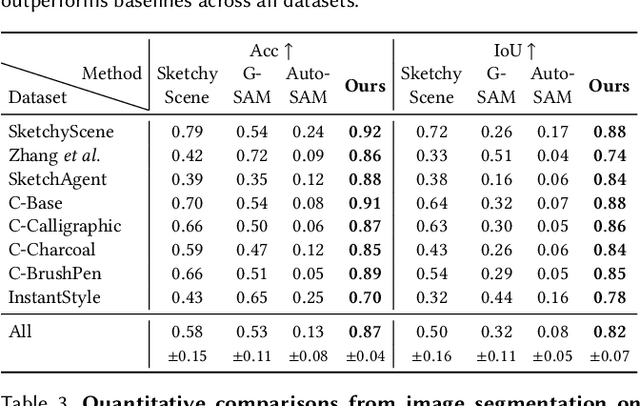
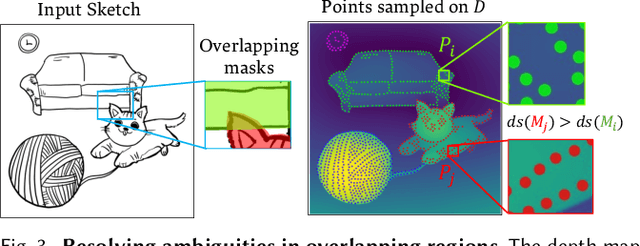
Abstract:Sketch segmentation involves grouping pixels within a sketch that belong to the same object or instance. It serves as a valuable tool for sketch editing tasks, such as moving, scaling, or removing specific components. While image segmentation models have demonstrated remarkable capabilities in recent years, sketches present unique challenges for these models due to their sparse nature and wide variation in styles. We introduce SketchSeg, a method for instance segmentation of raster scene sketches. Our approach adapts state-of-the-art image segmentation and object detection models to the sketch domain by employing class-agnostic fine-tuning and refining segmentation masks using depth cues. Furthermore, our method organizes sketches into sorted layers, where occluded instances are inpainted, enabling advanced sketch editing applications. As existing datasets in this domain lack variation in sketch styles, we construct a synthetic scene sketch segmentation dataset featuring sketches with diverse brush strokes and varying levels of detail. We use this dataset to demonstrate the robustness of our approach and will release it to promote further research in the field. Project webpage: https://sketchseg.github.io/sketch-seg/
SwiftSketch: A Diffusion Model for Image-to-Vector Sketch Generation
Feb 12, 2025

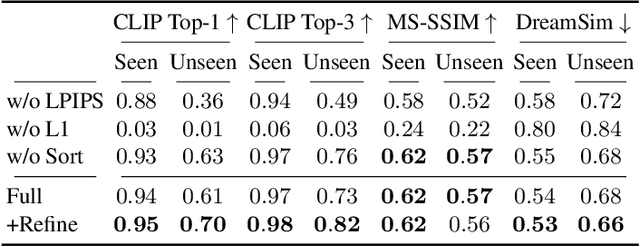
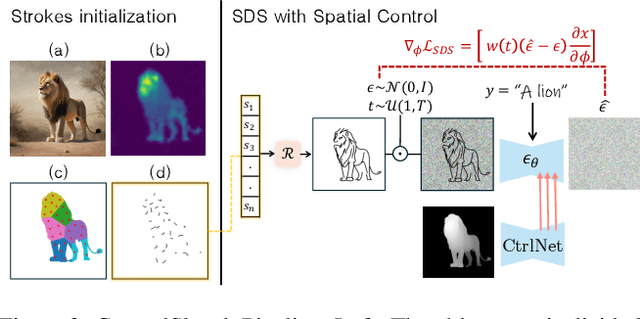
Abstract:Recent advancements in large vision-language models have enabled highly expressive and diverse vector sketch generation. However, state-of-the-art methods rely on a time-consuming optimization process involving repeated feedback from a pretrained model to determine stroke placement. Consequently, despite producing impressive sketches, these methods are limited in practical applications. In this work, we introduce SwiftSketch, a diffusion model for image-conditioned vector sketch generation that can produce high-quality sketches in less than a second. SwiftSketch operates by progressively denoising stroke control points sampled from a Gaussian distribution. Its transformer-decoder architecture is designed to effectively handle the discrete nature of vector representation and capture the inherent global dependencies between strokes. To train SwiftSketch, we construct a synthetic dataset of image-sketch pairs, addressing the limitations of existing sketch datasets, which are often created by non-artists and lack professional quality. For generating these synthetic sketches, we introduce ControlSketch, a method that enhances SDS-based techniques by incorporating precise spatial control through a depth-aware ControlNet. We demonstrate that SwiftSketch generalizes across diverse concepts, efficiently producing sketches that combine high fidelity with a natural and visually appealing style.
NeuralSVG: An Implicit Representation for Text-to-Vector Generation
Jan 07, 2025Abstract:Vector graphics are essential in design, providing artists with a versatile medium for creating resolution-independent and highly editable visual content. Recent advancements in vision-language and diffusion models have fueled interest in text-to-vector graphics generation. However, existing approaches often suffer from over-parameterized outputs or treat the layered structure - a core feature of vector graphics - as a secondary goal, diminishing their practical use. Recognizing the importance of layered SVG representations, we propose NeuralSVG, an implicit neural representation for generating vector graphics from text prompts. Inspired by Neural Radiance Fields (NeRFs), NeuralSVG encodes the entire scene into the weights of a small MLP network, optimized using Score Distillation Sampling (SDS). To encourage a layered structure in the generated SVG, we introduce a dropout-based regularization technique that strengthens the standalone meaning of each shape. We additionally demonstrate that utilizing a neural representation provides an added benefit of inference-time control, enabling users to dynamically adapt the generated SVG based on user-provided inputs, all with a single learned representation. Through extensive qualitative and quantitative evaluations, we demonstrate that NeuralSVG outperforms existing methods in generating structured and flexible SVG.
Generative Visual Communication in the Era of Vision-Language Models
Nov 27, 2024
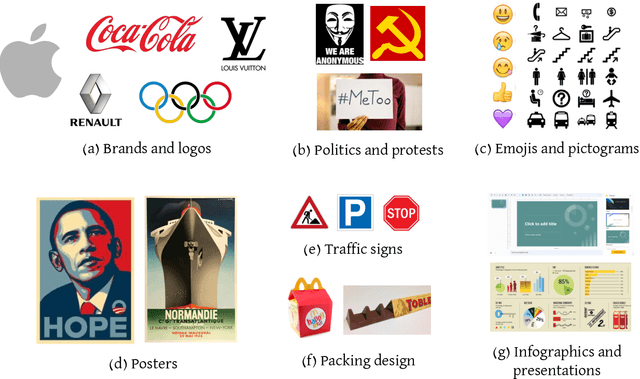
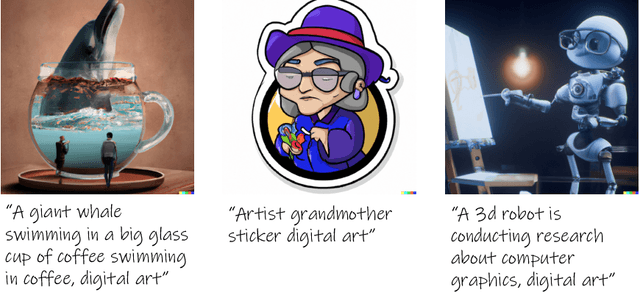
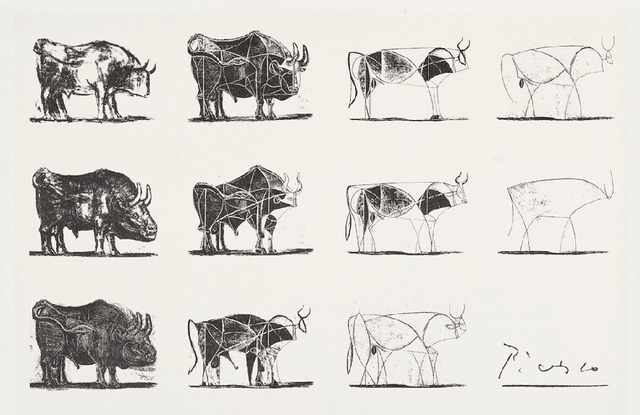
Abstract:Visual communication, dating back to prehistoric cave paintings, is the use of visual elements to convey ideas and information. In today's visually saturated world, effective design demands an understanding of graphic design principles, visual storytelling, human psychology, and the ability to distill complex information into clear visuals. This dissertation explores how recent advancements in vision-language models (VLMs) can be leveraged to automate the creation of effective visual communication designs. Although generative models have made great progress in generating images from text, they still struggle to simplify complex ideas into clear, abstract visuals and are constrained by pixel-based outputs, which lack flexibility for many design tasks. To address these challenges, we constrain the models' operational space and introduce task-specific regularizations. We explore various aspects of visual communication, namely, sketches and visual abstraction, typography, animation, and visual inspiration.
SketchAgent: Language-Driven Sequential Sketch Generation
Nov 26, 2024Abstract:Sketching serves as a versatile tool for externalizing ideas, enabling rapid exploration and visual communication that spans various disciplines. While artificial systems have driven substantial advances in content creation and human-computer interaction, capturing the dynamic and abstract nature of human sketching remains challenging. In this work, we introduce SketchAgent, a language-driven, sequential sketch generation method that enables users to create, modify, and refine sketches through dynamic, conversational interactions. Our approach requires no training or fine-tuning. Instead, we leverage the sequential nature and rich prior knowledge of off-the-shelf multimodal large language models (LLMs). We present an intuitive sketching language, introduced to the model through in-context examples, enabling it to "draw" using string-based actions. These are processed into vector graphics and then rendered to create a sketch on a pixel canvas, which can be accessed again for further tasks. By drawing stroke by stroke, our agent captures the evolving, dynamic qualities intrinsic to sketching. We demonstrate that SketchAgent can generate sketches from diverse prompts, engage in dialogue-driven drawing, and collaborate meaningfully with human users.
Implicit Style-Content Separation using B-LoRA
Mar 21, 2024Abstract:Image stylization involves manipulating the visual appearance and texture (style) of an image while preserving its underlying objects, structures, and concepts (content). The separation of style and content is essential for manipulating the image's style independently from its content, ensuring a harmonious and visually pleasing result. Achieving this separation requires a deep understanding of both the visual and semantic characteristics of images, often necessitating the training of specialized models or employing heavy optimization. In this paper, we introduce B-LoRA, a method that leverages LoRA (Low-Rank Adaptation) to implicitly separate the style and content components of a single image, facilitating various image stylization tasks. By analyzing the architecture of SDXL combined with LoRA, we find that jointly learning the LoRA weights of two specific blocks (referred to as B-LoRAs) achieves style-content separation that cannot be achieved by training each B-LoRA independently. Consolidating the training into only two blocks and separating style and content allows for significantly improving style manipulation and overcoming overfitting issues often associated with model fine-tuning. Once trained, the two B-LoRAs can be used as independent components to allow various image stylization tasks, including image style transfer, text-based image stylization, consistent style generation, and style-content mixing.
SEVA: Leveraging sketches to evaluate alignment between human and machine visual abstraction
Dec 05, 2023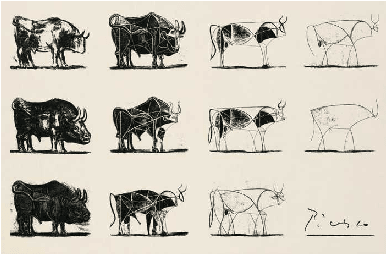

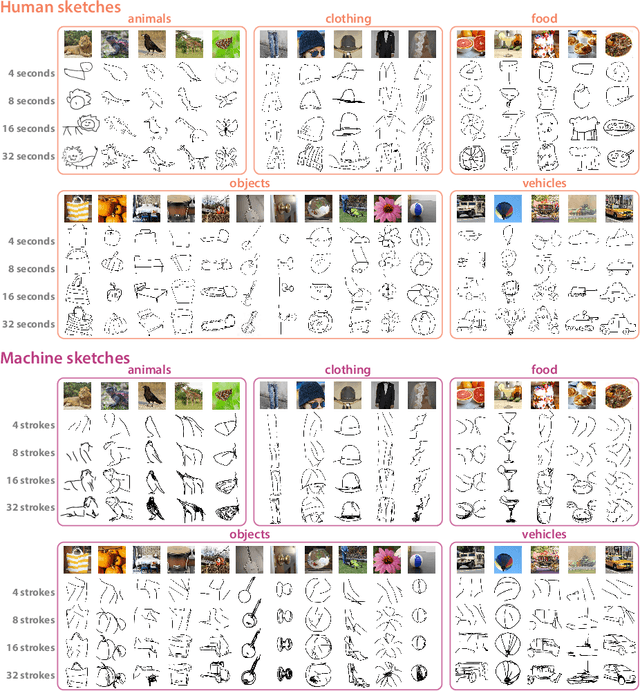
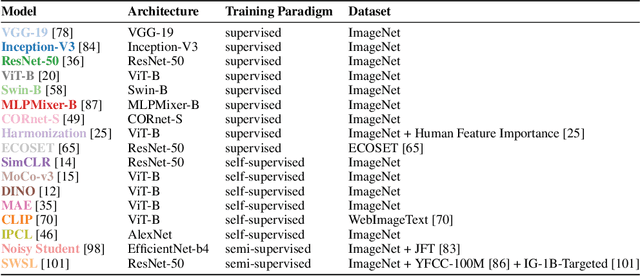
Abstract:Sketching is a powerful tool for creating abstract images that are sparse but meaningful. Sketch understanding poses fundamental challenges for general-purpose vision algorithms because it requires robustness to the sparsity of sketches relative to natural visual inputs and because it demands tolerance for semantic ambiguity, as sketches can reliably evoke multiple meanings. While current vision algorithms have achieved high performance on a variety of visual tasks, it remains unclear to what extent they understand sketches in a human-like way. Here we introduce SEVA, a new benchmark dataset containing approximately 90K human-generated sketches of 128 object concepts produced under different time constraints, and thus systematically varying in sparsity. We evaluated a suite of state-of-the-art vision algorithms on their ability to correctly identify the target concept depicted in these sketches and to generate responses that are strongly aligned with human response patterns on the same sketch recognition task. We found that vision algorithms that better predicted human sketch recognition performance also better approximated human uncertainty about sketch meaning, but there remains a sizable gap between model and human response patterns. To explore the potential of models that emulate human visual abstraction in generative tasks, we conducted further evaluations of a recently developed sketch generation algorithm (Vinker et al., 2022) capable of generating sketches that vary in sparsity. We hope that public release of this dataset and evaluation protocol will catalyze progress towards algorithms with enhanced capacities for human-like visual abstraction.
The Chosen One: Consistent Characters in Text-to-Image Diffusion Models
Nov 27, 2023
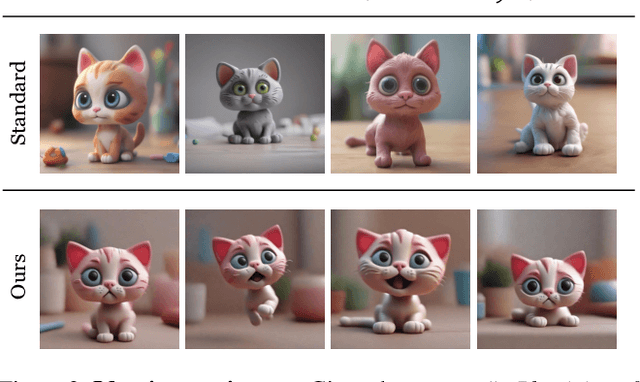


Abstract:Recent advances in text-to-image generation models have unlocked vast potential for visual creativity. However, these models struggle with generation of consistent characters, a crucial aspect for numerous real-world applications such as story visualization, game development asset design, advertising, and more. Current methods typically rely on multiple pre-existing images of the target character or involve labor-intensive manual processes. In this work, we propose a fully automated solution for consistent character generation, with the sole input being a text prompt. We introduce an iterative procedure that, at each stage, identifies a coherent set of images sharing a similar identity and extracts a more consistent identity from this set. Our quantitative analysis demonstrates that our method strikes a better balance between prompt alignment and identity consistency compared to the baseline methods, and these findings are reinforced by a user study. To conclude, we showcase several practical applications of our approach. Project page is available at https://omriavrahami.com/the-chosen-one
Breathing Life Into Sketches Using Text-to-Video Priors
Nov 21, 2023
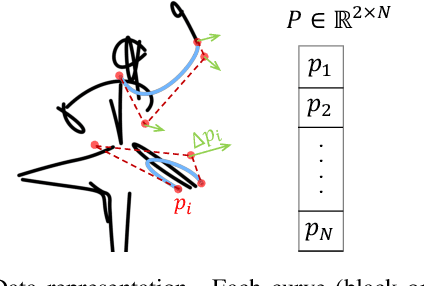
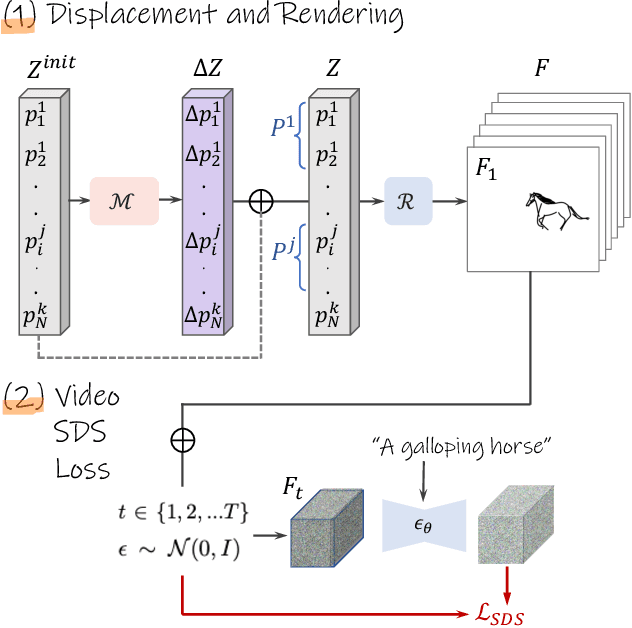

Abstract:A sketch is one of the most intuitive and versatile tools humans use to convey their ideas visually. An animated sketch opens another dimension to the expression of ideas and is widely used by designers for a variety of purposes. Animating sketches is a laborious process, requiring extensive experience and professional design skills. In this work, we present a method that automatically adds motion to a single-subject sketch (hence, "breathing life into it"), merely by providing a text prompt indicating the desired motion. The output is a short animation provided in vector representation, which can be easily edited. Our method does not require extensive training, but instead leverages the motion prior of a large pretrained text-to-video diffusion model using a score-distillation loss to guide the placement of strokes. To promote natural and smooth motion and to better preserve the sketch's appearance, we model the learned motion through two components. The first governs small local deformations and the second controls global affine transformations. Surprisingly, we find that even models that struggle to generate sketch videos on their own can still serve as a useful backbone for animating abstract representations.
Concept Decomposition for Visual Exploration and Inspiration
May 31, 2023Abstract:A creative idea is often born from transforming, combining, and modifying ideas from existing visual examples capturing various concepts. However, one cannot simply copy the concept as a whole, and inspiration is achieved by examining certain aspects of the concept. Hence, it is often necessary to separate a concept into different aspects to provide new perspectives. In this paper, we propose a method to decompose a visual concept, represented as a set of images, into different visual aspects encoded in a hierarchical tree structure. We utilize large vision-language models and their rich latent space for concept decomposition and generation. Each node in the tree represents a sub-concept using a learned vector embedding injected into the latent space of a pretrained text-to-image model. We use a set of regularizations to guide the optimization of the embedding vectors encoded in the nodes to follow the hierarchical structure of the tree. Our method allows to explore and discover new concepts derived from the original one. The tree provides the possibility of endless visual sampling at each node, allowing the user to explore the hidden sub-concepts of the object of interest. The learned aspects in each node can be combined within and across trees to create new visual ideas, and can be used in natural language sentences to apply such aspects to new designs.
 Add to Chrome
Add to Chrome Add to Firefox
Add to Firefox Add to Edge
Add to Edge